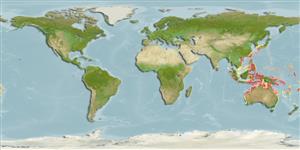Classification / Names
Common names | Synonyms | Catalog of Fishes (gen., sp.) | ITIS | CoL | WoRMS | Cloffa
Actinopterygii (ray-finned fishes) >
Perciformes (Perch-likes) >
Apogonidae (Cardinalfishes) > Apogoninae
Etymology: monospilus: Name from Greek words 'mono' for one and 'spilos' for spot, referring to a single white spot present in life; noun in apposition.
Environment / Climate / Range
Ecology
Marine; reef-associated; depth range 2 - 41 m (Ref. 58519). Tropical, preferred ?
Indo-Pacific: Philippines, Indonesia, Papua New Guinea, and Australia.
Size / Weight / Age
Maturity: Lm ? range ? - ? cm
Max length : 7.8 cm SL male/unsexed; (Ref. 58519)
Short description
Morphology | Morphometrics
Dorsal
spines
(total): 8;
Dorsal
soft rays
(total): 9;
Anal
spines: 2;
Anal
soft rays: 8;
Vertebrae: 24. This species is characterized by having 26-28 rudiments + 19-21 lower arch developed gill rakers; roof of mouth and portions of gill arches darkish; a whitish spot behind posterior base of second dorsal fin (Ref. 58519).
Nocturnal species which inhabits coral reef (Ref. 75154). Most specimens were collected from deeper waters (Ref. 58519). In pairs or groups (Ref 90102).
Life cycle and mating behavior
Maturity | Reproduction | Spawning | Eggs | Fecundity | Larvae
Fraser, T.H., J.E. Randall and G.R. Allen, 2002. Clarification of the cardinalfishes (Apogonidae) previoulsly confused with Apogon moluccensis Valenciennes, with a description of a related new species. Raffles Bull. Zool. 50(1):175-184. (Ref. 58519)
IUCN Red List Status (Ref. 115185)
CITES (Ref. 94142)
Not Evaluated
Threat to humans
Harmless
Human uses
More information
Common namesSynonymsMetabolismPredatorsEcotoxicologyReproductionMaturitySpawningFecundityEggsEgg development
Age/SizeGrowthLength-weightLength-lengthLength-frequenciesMorphometricsMorphologyLarvaeLarval dynamicsRecruitmentAbundance
ReferencesAquacultureAquaculture profileStrainsGeneticsAllele frequenciesHeritabilityDiseasesProcessingMass conversion
Tools
Special reports
Download XML
Internet sources
